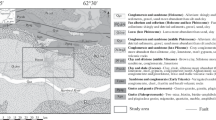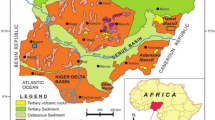Abstract
The hydrogeochemical parameters for groundwater samples of the Varanasi area, a fast-urbanizing region in India, were studied to evaluate the major ion chemistry, weathering and solute acquisition processes controlling water composition, and suitability of water quality for domestic and irrigation uses. Sixty-eight groundwater samples were collected randomly from dug wells and hand pumps in the urban Varanasi area and analyzed for various chemical parameters. Geologically, the study area comprises Quaternary alluvium made up of an alternating succession of clay, silty clay, and sand deposits. The Total dissolved solids classification reveals that except two locations, the groundwater samples are desirable for drinking, and all are useful for irrigation purposes. The cationic and anionic concentrations indicated that the majority of the groundwater samples belong to the order of Na > Ca > Mg > K and HCO3 > Cl > SO4 types, respectively. Geochemical classification of groundwater based on the Chadha rectangular diagram shows that the majority (81%) of groundwater samples belong to the calcium–bicarbonate type. The HCO3/ (HCO3 + SO4) ratio (0.87) indicates mostly carbonic acid weathering process due to presence of kankar carbonate mixed with clay/fine sand. The high nitrate concentration (>45 mg/l) of about 18% of the groundwater samples may be due to the local domestic sewage, leakage of septic tanks, and improper management of sanitary landfills. In general, the calculated values of sodium adsorption ratio, percent sodium, residual sodium carbonate, and permeability index indicate good to permissible use of water for irrigation, and only a few locations demand remedial measures for better crop yields.
Similar content being viewed by others
References
Agrawal, V., & Jagetia, M. (1997). Hydrogeochemical assessment of groundwater quality in Udaipur City, Rajasthan, India. In Proceedings of national conference on dimension of environmental stress in India (pp. 151–154). Department of Geology, MS University, Baroda, India.
APHA (1995). Standard methods for the examination of water and wastewater, 19th Edn. Washington: American Public Health Association.
Appelo, C. A. J., & Postma, D. (1993). Geochemistry, groundwater and pollution. Rotterdam: AA Balkema.
Aravindan, S., Manivel, M., & Chandrasekar, S. V. N. (2004). Groundwater quality in the hard rock area of the Gadilam River Basin, Tamilnadu. Journal of the Geological Society of India, 63, 625–635.
Ayers, R. S., & Wescot, D. W. (1985). Water quality for irrigation. FAO Irrigation and Drainage Paper No. 20, Rev 1. Rome, FAO.
Balasubramanian, A. (1986). Hydrogeological investigations in the Tambraparani River basin, Tamilnadu (345 p.). Ph.D. thesis, University of Mysore.
Berner, E. K., & Berner, R. A. (1987). The global water cycle: Geochemistry and environment. Englewood Cliffs: Prentice-Hall.
Bilas, R. (1980). Groundwater resources of Varanasi district, India: An assessment of conditions, use and quality. The National Geographical Journal of India, 26(1–2), 81–93.
BIS (1991). Indian standard specification for drinking water. IS: 10500, Bureau of Indian Standards.
Chadha, D. K. (1999). A proposed new diagram for geochemical classification of natural waters and interpretation of chemical data. Hydrogeology Journal, 7, 431–439.
Collins, R., & Jenkins, A. (1996). The impact of agricultural land use on stream chemistry in the middle hills of the Himalayas, Nepal. Journal of Hydrology, 185, 71–86.
Davis, S. N., & De Wiest, R. J. M. (1966). Hydrogeology (Vol. 463). New York: Wiley.
Domenico, P. A., & Schwartz, F. W. (1990). Physical and chemical hydrology. New York: Wiley.
Doneen, L. D. (1964). Notes on water quality in agriculture. Water Science and Engineering Paper 4001, California, Department of Water Sciences and Engineering, University of California.
Drever, J. I. (1988). The geochemistry of natural waters. Englewood Cliffs: Prentice Hall.
Eaton, F. M. (1950). Significance of carbonates in irrigation waters. Soil science, 39, 123–133.
Eswari, Y. N. K., & Ramanibai, R. (2000). Trace metal distribution in the estuarine waters of Chennai, South East coast of India. In Proceedings of analytical techniques in monitoring the environment (pp. 333–338).
Faure, G. (1998). Principles and applications of geochemistry, 2nd Edn. Englewood Cliffs: Prentice Hall.
Fetter, C. W. (1990). Applied hydrogeology (2nd Edn., 592 p.). New Delhi: CBS Publishers and Distributors.
Gibbs, R. J. (1970). Mechanism controlling world water chemistry. Science, 170, 1088–1090.
Hem, J. D. (1991). Study and interpretation of the chemical characteristics of natural waters (263). USGS Water Survey Paper 2254.
Johnson, C. C. (1979). Land application of waste—An accident waiting to happen. Groundwater, 17(1), 69–72.
Karanth, K. R. (1989). Groundwater assessment, development and management. New Delhi: Tata McGraw-Hill Publ. Com. Ltd.
Krothe, N. C., & Oliver, J. W. (1982). Sulfur isotopic composition and water chemistry from the high plains aquifer, Oklahoma panhandle and south-western Kansas (28 p.). U.S. Geological Survey Water Resources Investigations, 82–12.
Lowson, R. T., Reedy, B. J., & Beattie, J. K. (1993). The chemistry of acid mine drainage. Chemistry in Australia, 60, 389–391.
Maiti, T. C. (1982). The dangerous acid rain. Science Reporter, 9, 360–363.
Majumdar, D., & Gupta, N. (2000). Nitrate pollution of groundwater and associated human health disorders. Indian Journal of Environmental Health, 42, 28–39.
Moses, E. (1994). Hydrogeological studies in the Ayyar River basin, Tamilnadu (282 p.). Thesis, Bharathidasan University.
Nolan, B. T. (2001). Relating nitrogen sources and aquifer susceptibility to nitrate in shallow ground water of the United States. Ground Water, 39, 290–300.
Pandey, S. K., Singh, A. K., & Hasnain, S. I. (2001). Hydrochemical characteristics of meltwater draining from Pindari glacier, Kumon Himalaya. Journal of the Geological Society of India, 57, 519–527.
Raghunath, H. M. (1987). Groundwater. Delhi: Wiley Eastern Ltd.
Raju, N. J. (2006a). Seasonal evaluation of hydro-geochemical parameters using correlation and regression analysis. Current Science, 91(6), 820–826.
Raju, N. J. (2006b). Iron contamination in groundwater: A case from Tirumala-Tirupati environs, India. The Researcher, 1(1), 28–31.
Raju, N. J. (2007). Hydrogeochemical parameters for assessment of groundwater quality in the upper Gunjanaeru River basin, Cuddapah district, Andhra Pradesh, South India. Environmental Geology, 52, 1067–1074.
Raju, N. J., Kotaiah, B., & Reddy, T. V. K. (1991). Biogeochemical aspects in and around a sewage farm at Tirupati, Andhra Pradesh, India. Environmental Conservation, 18(3), 267–269.
Raju, N. J., Ram, P., & Dey, S. (2009). Groundwater quality in the lower Varuna River basin, Varanasi district, Uttar Pradesh, India. Journal of Geological Society of India, 73, 178–192.
Raju, N. J., & Reddy, T. V. K. (2007). Environmental and urbanization affect on groundwater resources in a pilgrim town of Tirupati, Andhra Pradesh, South India. Journal of Applied Geochemistry, 9(2), 212–223.
Raju, N. J., Reddy, T. V. K., Kotaiah, B., & Nayudu, P. T. (1992). A study on seasonal variations of groundwater quality in upper Gunjanaeru River basin, Cuddapah district, Andhra Pradesh. Fresenius Environmental Bulletin, 1, 98–103.
Ray, S. K., Ghosh, S., Tiwari, I. C., Kaur, P., Reddy, D. C. S., & Nagchaudhuri, J. (1983). Dental fluorosis in Ledhupur and Rustampur villages near Varanasi. Indian Journal of Medical Research, 77, 112–118.
Reddy, C. V., Kotaiah, B., & Raju, N. J. (1992). A study on groundwater quality near a municipal solid waste disposal site at Tirupati, Andhra Pradesh, India. Fresenius Environmental Bulletin, 1(13), 93–97.
Richards, L. A. (1954). Diagnosis and improvement of saline and alkali soils. Hand Book, No. 60. U.S. Department of Agriculture, Washington, D.C.
Saleh, A., Al-Ruwaih, F., & Shehata, M. (1999). Hydrogeochemical processes operating within the main aquifers of Kuwait. Journal of Arid Environments, 42, 195–209.
Sankar, K. (1995). Hydrological studies in the Kanyakumari district, Tamilnadu (pp. 90–91). Ph.D. thesis, University of Madras.
Sarin, M. M., Krishnaswamy, S., Dilli, K., Somayajulu, B. L. K., & Moore, W. S. (1989). Major ion chemistry of the Ganga–Brahmaputra river system: Weathering processes and fluxes to the Bay of Bengal. Geochimica et Cosmochimica Acta, 53, 997–1009.
Sastri, J. C. V. (1994). Groundwater chemical quality in river basins, hydrogeochemical facies and hydrogeochemical modeling. Lecture notes—Refresher course conducted by School of Earth Sciences, Bharathidasan University, Thiruchirapalli, Tamil Nadu, India.
Sawyer, C., & Mc Carthy, P. (1967). Chemical and sanitary engineering, 2nd Edn. New York: McGraw-Hill.
Schilling, K. E., & Wolter, C. F. (2007). A GIS-based groundwater travel time model to evaluate stream nitrate concentration reductions from land use change. Environmental Geology, 53, 433–443.
Schoeller, H. (1977). Geochemistry of groundwater. In Groundwater studies—An international guide for research and practice (Ch. 15, pp. 1–18). UNESCO, Paris.
Shih, R. D., Marcus, S. M., & Gnense, C. A. (1997). Methemoglobinemia attributable to nitrate contamination of potable water through boiler fluid additives—New Jersey, 1992 and 1996. Morbidity and Mortality Weekly Report, 46, 202–204.
Shukla, U. K., & Raju, N. J. (2008). Migration of Ganga River and its implication on hydro-geological potential of Varanasi area, U. P. Journal of Earth System Sciences, 117(4), 489–498.
Singh, U. K., Kumar, M., Chauhan, R., Jha, P. K., Ramanathan, A. L., & Subramanian, V. (2008). Assessment of the impact of landfill on groundwater quality: A case study of the Pirana site in western India. Environmental Monitoring and Assessment, 141, 309–321.
Sinha, T. K. (2003). Groundwater conditions and its quality in Varanasi city. Indian Journal of Geomorphology, 8(1–2), 153–154.
Srinivasan, P. R. (1992). Hydrological studies of Mamundiyar River basin, Tamilnadu (pp. 16–20). Ph.D. thesis, Bharathidasan University.
Szabolcs, I., & Darab, C. (1964). The influence of irrigation water of high sodium carbonate content of soils. In Proceedings of 8th international congress of ISSS, Trans, II (pp. 803–812).
Todd, D. K. (1980). Groundwater hydrology, 2nd Edn. New York: Wiley.
Umar, R., Khan, M. M. A., & Absar, A. (2006). Groundwater hydrochemistry of a sugarcane cultivation belt in parts of Muzaffarnagar district, Uttar Pradesh, India. Environmental Geology, 49, 999–1008.
US Salinity Laboratory (1954). Diagnosis and improvement of saline and alkali soils. Agricultural Hand book No. 60, USDA, 160p.
Viets, F. G. (1974). Nitrogen transformation in organic waste applied to land. In National Program Staff: Factors involved in land application of agricultural and municipal wastes (DRAFT) (pp. 51–65). Beltsville: ARS, USDA, 200p.
WHO (1997). Guideline for drinking water quality. Recommendations (Vol. 1, 2nd Edn). Geneva: WHO.
Wilcox, L. V. (1948). Classification and use of irrigation waters. Washington: U.S. Department of Agriculture, Cir 962.
Wilhelm, S. R., Schiff, S. L., & Cherry, J. A. (1994). Biogeochemical of domestic waste water in septic system: 1. Conceptual model. Ground Water, 32, 915–905.
Author information
Authors and Affiliations
Corresponding author
Rights and permissions
About this article
Cite this article
Janardhana Raju, N., Shukla, U.K. & Ram, P. Hydrogeochemistry for the assessment of groundwater quality in Varanasi: a fast-urbanizing center in Uttar Pradesh, India. Environ Monit Assess 173, 279–300 (2011). https://doi.org/10.1007/s10661-010-1387-6
Received:
Accepted:
Published:
Issue Date:
DOI: https://doi.org/10.1007/s10661-010-1387-6




